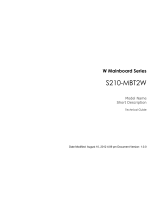
Using the Baseboard Management Controller
JViewer Menu
The
JViewer menu provides access
to
additional functions, outlined
in the
following
tables.
Table 1-6. Video Menu Items
Menu Option Description
Start Redirection Begin console
redirection. Stop Redirection Stop console
redirection.
Restart Stop and then restart console redirection.
Full Screen View the console redirection in full screen
mode. Exit Exit console redirection.
Table 1-7. Keyboard Menu Items
Menu Option Description
Hold Right Ctrl Key Apply the right <Ctrl> key to the next keystroke sent to the remote
system. Hold Right Alt Key Apply the right <Alt> key to the next keystroke sent to the
remote system. Hold Left Ctrl Key Apply the left <Ctrl> key to the next keystroke sent to the
remote system. Hold Left Alt Key Apply the left <Alt> key to the next keystroke sent to the
remote system.
Left Windows Key Select Hold Down before typing characters you want to combine with the left
Windows key.
Select Press and Release to send a left Windows key keystroke.
Right Windows Key Select Hold Down before typing characters you want to combine with the right
Windows key.
Select Press and Release to send a right Windows key keystroke.
Alt+Ctrl+Del Send the <Ctrl><Alt><Delete> key combination to the remote system.
Full Keyboard Direct client keyboard functions to the server.
Table 1-8. Mouse Menu Items
Menu Option Description
Sync Cursor
Synchronize
the local cursor with the
remote
cursor. The remote client’s cursor
and the server’s cursor appear together onscreen.
Single Cursor Disable the remote client’s cursor and view only the server’s cursor. This
resolves the issue of the remote mouse not working correctly under LSI
8708EM2
WebBIOS.






















